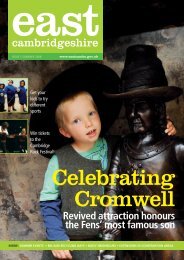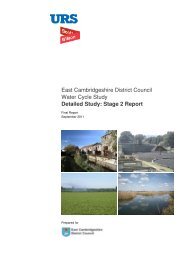6. Soham Conservation Area - East Cambridgeshire District Council
6. Soham Conservation Area - East Cambridgeshire District Council
6. Soham Conservation Area - East Cambridgeshire District Council
You also want an ePaper? Increase the reach of your titles
YUMPU automatically turns print PDFs into web optimized ePapers that Google loves.
7.5 From the west, views are across open farmland with the Mill complex<br />
dominating the foreground and elements of the former railway still<br />
visible. Although the River Snail has been partially canalised for the<br />
mill’s use, it creates a picturesque setting in this rural location. Entering<br />
the village from the north has a very different feel, as development is<br />
sparser with modern housing more apparent and an industrial estate<br />
containing offices and light industrial units.<br />
8 Archaeology<br />
8.1 There are no Scheduled Ancient Monuments and very little evidence of<br />
prehistoric activity within the urban core of <strong>Soham</strong> and little Roman<br />
material apart from a cemetery beneath White Hart Lane. A Roman<br />
villa is, however, known to have existed on the mainland towards<br />
Wicken and also out at Barway where a more extensive rural<br />
settlement is know. The modern town of <strong>Soham</strong> dates largely from<br />
Anglo-Saxon times from which there are three distinct phases of<br />
activity; the pagan period (early Saxon), Middle Saxon and Late Saxon.<br />
8.2 Three pagan period cemeteries exist in the area; one in the historic<br />
core of <strong>Soham</strong>, and two adjacent elsewhere in the town. The enclosure<br />
associated with the early abbey church reputedly founded by Bishop<br />
Felix with the patronage of the king or a noble in the 7 th century is<br />
probably fossilised in the street pattern of modern <strong>Soham</strong>. Excavations<br />
have shown that boundary ditches existed in the later 10 th century<br />
which appear to respect the alignment of both High Street and Station<br />
Road suggesting that these elements of the streetscape were in place<br />
by then.<br />
8.3 The medieval period expanded on the late Saxon period core that<br />
already existed and property boundaries along the High Street<br />
preserve the outline of tenements and burgess plots. There is a<br />
moated enclosure by the mill complex that developed where the River<br />
Snail entered <strong>Soham</strong> Mere.<br />
8.4 The main survival of medieval <strong>Soham</strong> is in the field system. The town<br />
is unique in having an almost intact open field system surrounding the<br />
urban core, and was never enclosed. The two main fields (No Ditch<br />
Field and North Field) are amongst the finest remains of medieval<br />
agriculture in the country. Today <strong>Soham</strong> still has three commons, at<br />
Angles Common, <strong>East</strong> Fen and Qua Fen; it also has the South and<br />
North Horse Fens.<br />
9






